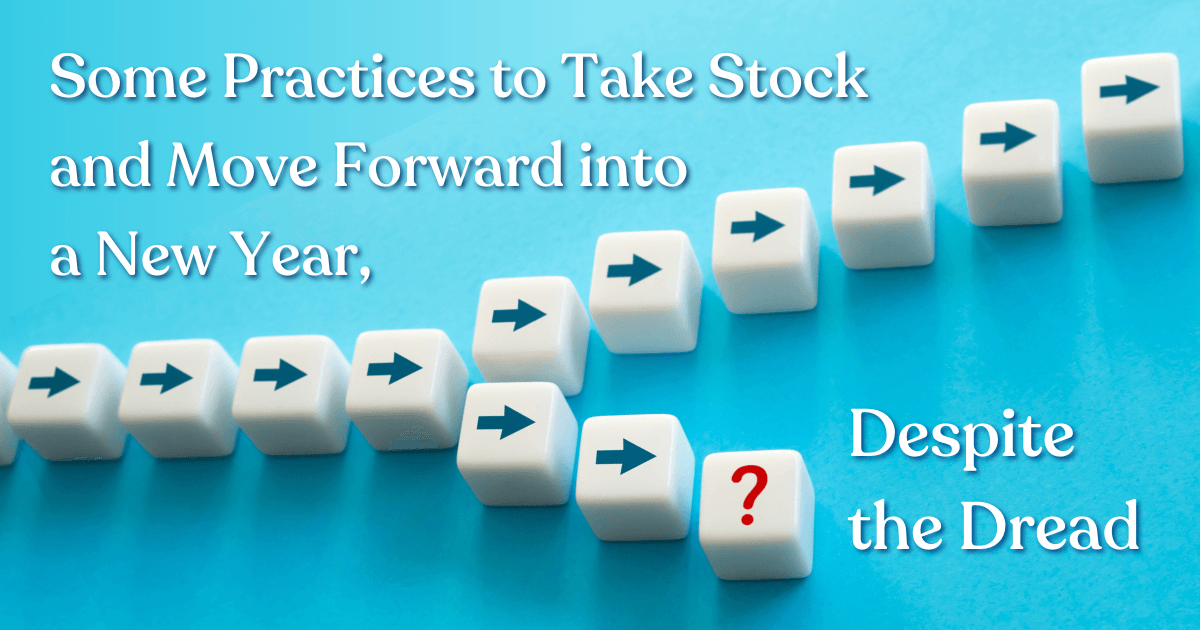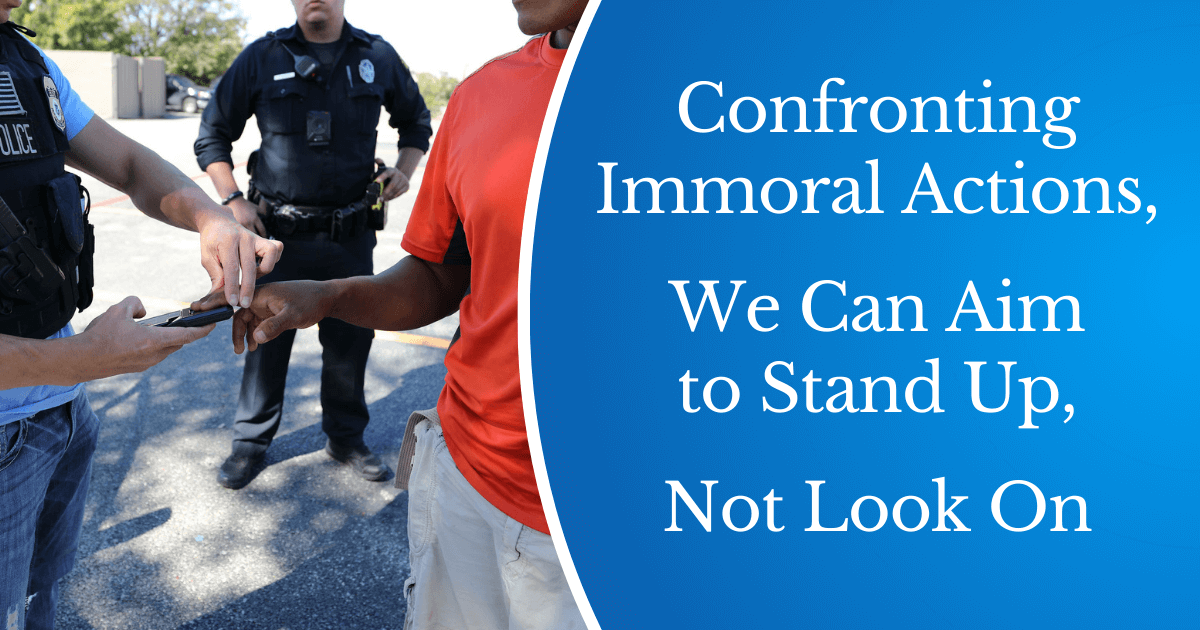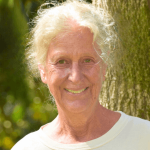Some Practices to Take Stock and Move Forward into a New Year, Despite the Dread

[Editor’s Note: This post, which comes to us from Kaethe Weingarten, PhD, Founder of Witness to Witness, was written before the Los Angeles area fires. Our hearts go out to all of those affected, and Dr. Weingarten and her team plan to respond to the fires, including here on the blog, in the coming weeks. Dr. Weingarten offers a newsletter, filled with resources, recent articles, and her news and views. Sign up for the newsletter and access bilingual resources on the Witness to Witness webpage.]
The first New Year’s celebration that I can remember, my father entered us into a costume contest. I was nearing my sixth birthday. He was dressed as Father Time and I was dressed as Baby New Year, wearing a diaper with a sash across my chest with the year 1953 written on it. Since then, I have experienced more than seventy other New Year’s days, each a bit different. Some have been quiet, some busy. Some solo, some with family, some with friends, some a combination of all of the above. There have been sunny, rainy, snowy, and cloudy days. I cannot remember one on which I have felt so much anticipatory dread.
At the Witness to Witness (W2W) Program, Pam, Jessica and I have been anticipating 2025 for seven months. Much of our work is captured by the Words Matter Campaign. I also published a guest essay in MindSite News (republished in the MCN blog) about one likely possibility in the coming year: I wrote about what I would do were I to see ICE officers interrogating a person they perceive as an unauthorized immigrant. I wrote about the process by which I could move from being a witness – a bystander – to an upstander.

Confronting Immoral Actions, We Can Aim to Stand Up, Not Look On
When the holidays approached, I felt I could take a break alongside my MCN colleagues to rest and recharge for the year ahead. But as I’ve returned to work, I have realized I need new enlivening practices to address the ongoing dread or, at the least, to create a daily life with more balance. I am adding activities so that I can live better alongside the new realities and the concomitant dread.
The first practice, a challenge which I am doing with a friend, is to try something new every day. We both started small. I reversed my morning ritual, getting dressed before making coffee and not the other way round. It turns out that there is science behind trying small, novel behaviors rather than sweeping changes. By keeping our expectations low, we are more likely to continue with our commitment. The fact that we check in with each other periodically also helps. We are both discovering how often we habitually do activities. Switching that up has been fun, funny, and a pleasure to share.
While I was contemplating what I could do that would be new, I happened upon a set of New Year’s prompts offered by Suleika Jaouad, whose work I deeply admire. She is going through chemotherapy for the third time – she has already endured two bone marrow transplants that have derailed her plans for her days, her weeks, her year, and her thinking about “forever.” I first encountered her through a column she wrote as a 22-year-old for The New York Times called “Life Interrupted,” which was followed by her book, Between Two Kingdoms: A Memoir of a Life Interrupted, about her time in the hospital and the road trip she took as part of her recovery. Her second bone marrow transplant coincided with the filming of American Symphony, which follows her husband, Jon Batiste, as he composes his first major composition, American Symphony. The film shows this newly married – although long-time friends – couple navigating her worst and his best year with profound love and creativity. The film is humbling and inspiring.
Jaouad’s prompts are not the usual transition time prompts. Or at least not ones with which I am familiar:
- What in the last year are you proud of?
- What did this year leave you yearning for?
- What’s causing you anxiety?
- What resources, skills, and practices can you rely on in the coming year?
- What are your wildest, most harebrained ideas and dreams?
I found it easy to answer questions 1 (the Words Matter campaign; help I gave to my children about their children), 3 and 4, but was stumped by questions 2 and 5. By contrast, my husband had no trouble with 2 and 5, but was uncertain about the other three. (I suppose that is a way of capturing our complementarity!) I have found it useful to think about why it is so hard for me to think creatively about the future or my future.
I will continue to think about this, but I have come up with one tentative explanation. I have spent a great deal of time in the last several months thinking about situations that fit this description: seemingly intractable situations over which one has limited control. These are situations that can often be summed up with a single noun, a noun like: “predicament,” “dilemma,” “crisis,” “impasse,” “vortex,” “catastrophe,” or “crux.” It's no wonder that a focus on news articles, podcasts, and stories that focus on the bleak and intractable makes it harder to pay attention to a hypothetical desirable future.

Realizing this, I am adding another “suggestion” to myself as I start the new year. (Notice I haven’t decided it’s a commitment. And by the way, research does show that one is more likely to be successful with a resolution to do something new if one decides to do it at a time of transition, be it Monday, the first day of the month, or the new year.) I am going to try to balance my attention to the dire with attention to the refreshing.
Focusing on what’s going wrong, on the dire, leads to demoralization. I am trying to catch myself feeling demoralized. When I am demoralized, I feel disheartened, discouraged, or defeated. It is as if nothing I can do matters since I am up against a force more powerful than I. Feeling effective again – re-moralized – usually comes from coming together with others to face the challenge that I, and often we, are experiencing. I am fortunate that my work at MCN and the Witness to Witness Program involves searching for and sharing ideas that re-moralize us, not just demoralize us. If our ideas require courage, then for me it is easier to be courageous when acting with others.
I want to end this post sharing what I did that was new this morning, just before writing this paragraph. (You can’t get more “hot of the press” than that!) I often follow links in what I am reading online on my computer. I have described this as working like a bird building her nest, using scavenged pieces of ideas, fragments, to build her nest. Today, I followed a link that had no relationship at all to anything I usually read. I just did it to enact my “something new each day” commitment and in the process, I learned something new but also realized that my scavenging stays pretty close to home, not geographically, of course, but conceptually. It was fun to read something that won’t make it into my nest -- an analysis of Pierce’s theory of the triangular nature of signs --unless, unless, hey! Maybe I’ll be making a new kind of nest this year! Bingo. My answer to prompt #5.
Resources and Next Steps:
- Read and journal on the five prompts provided by Suleika Jaouad on her substack, The Isolation Journals.
- Find practical solutions to moving from a bystander to an upstander: Confronting Immoral Actions, We Can Aim to Stand Up, Not Look On.
- Find more resources and information for clinicians to use with their migrant and immigrant patients at this moment in history: Words Matter
- Log in to post comments
